Health Promotion: Mental Health Intervention in Egypt for Young Adults
VerifiedAdded on 2023/06/03
|23
|6581
|478
Project
AI Summary
This project proposes a health promotion intervention to address mental health risks among young adults transitioning to adulthood in the MENA region of Egypt. The intervention focuses on education and counseling within schools to target individuals at risk early in life, addressing factors such as low educational attainment and limited employment opportunities. The action plan involves educational sessions to raise awareness about the importance of education and counseling sessions for early detection and intervention of mental health issues. The project aims to modify social norms related to gender biases, provide equal opportunities, and improve the overall well-being of youths in refugee camps, ultimately reducing mental health trauma and vulnerabilities. The effectiveness of the intervention will be evaluated through pre- and post-intervention surveys and analysis of school attendance and academic performance.
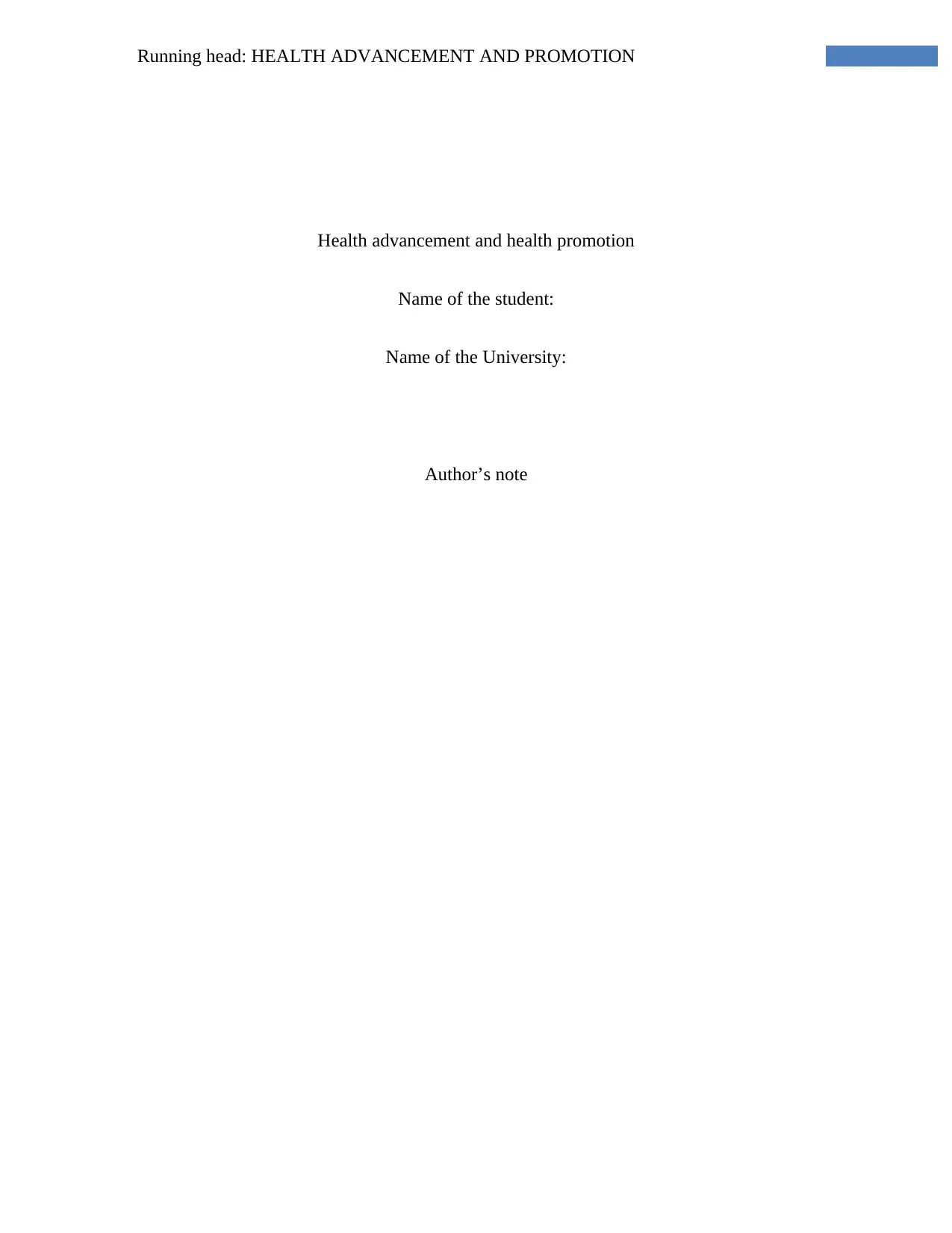
Running head: HEALTH ADVANCEMENT AND PROMOTION
Health advancement and health promotion
Name of the student:
Name of the University:
Author’s note
Health advancement and health promotion
Name of the student:
Name of the University:
Author’s note
Paraphrase This Document
Need a fresh take? Get an instant paraphrase of this document with our AI Paraphraser
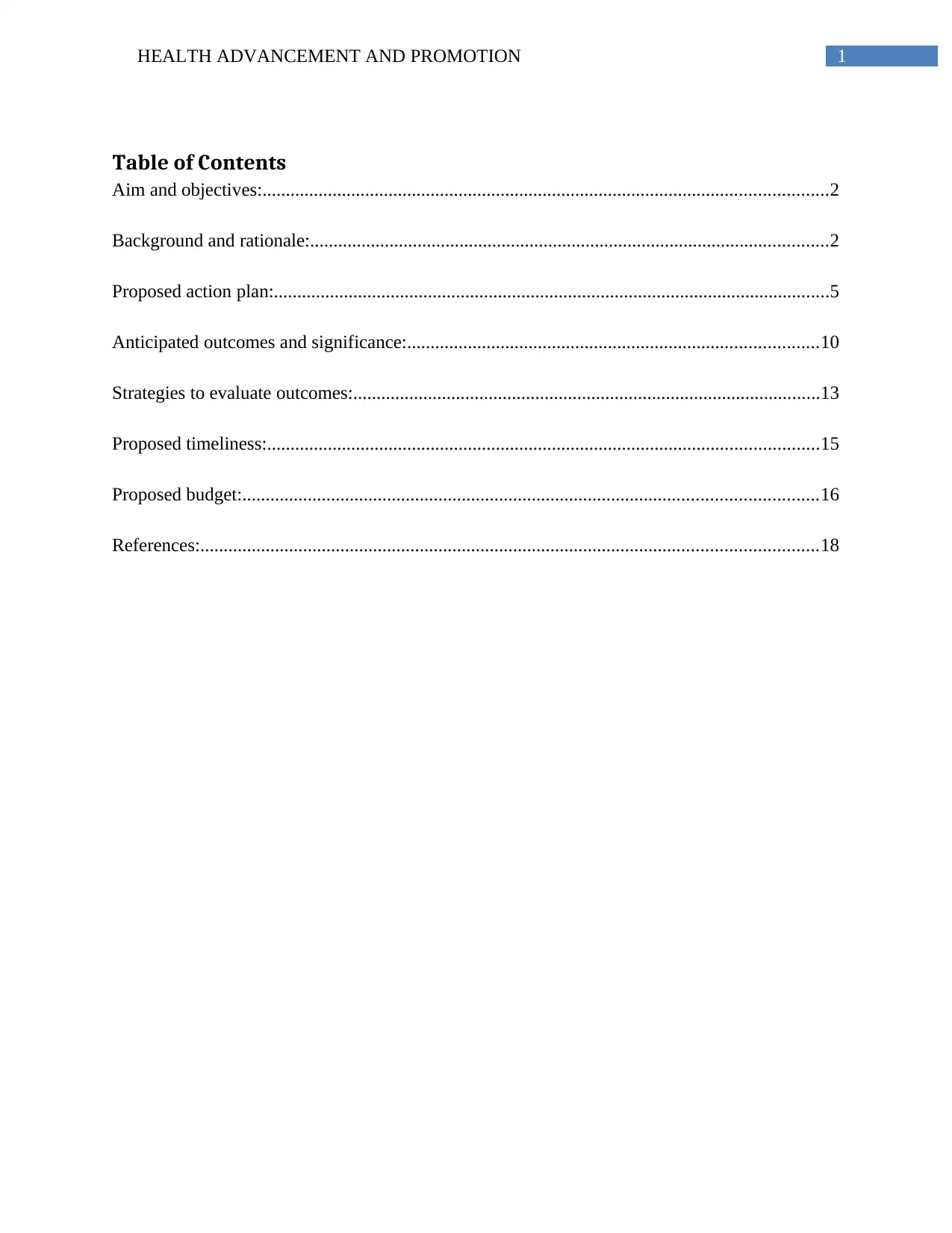
1HEALTH ADVANCEMENT AND PROMOTION
Table of Contents
Aim and objectives:.........................................................................................................................2
Background and rationale:...............................................................................................................2
Proposed action plan:.......................................................................................................................5
Anticipated outcomes and significance:........................................................................................10
Strategies to evaluate outcomes:....................................................................................................13
Proposed timeliness:......................................................................................................................15
Proposed budget:...........................................................................................................................16
References:....................................................................................................................................18
Table of Contents
Aim and objectives:.........................................................................................................................2
Background and rationale:...............................................................................................................2
Proposed action plan:.......................................................................................................................5
Anticipated outcomes and significance:........................................................................................10
Strategies to evaluate outcomes:....................................................................................................13
Proposed timeliness:......................................................................................................................15
Proposed budget:...........................................................................................................................16
References:....................................................................................................................................18
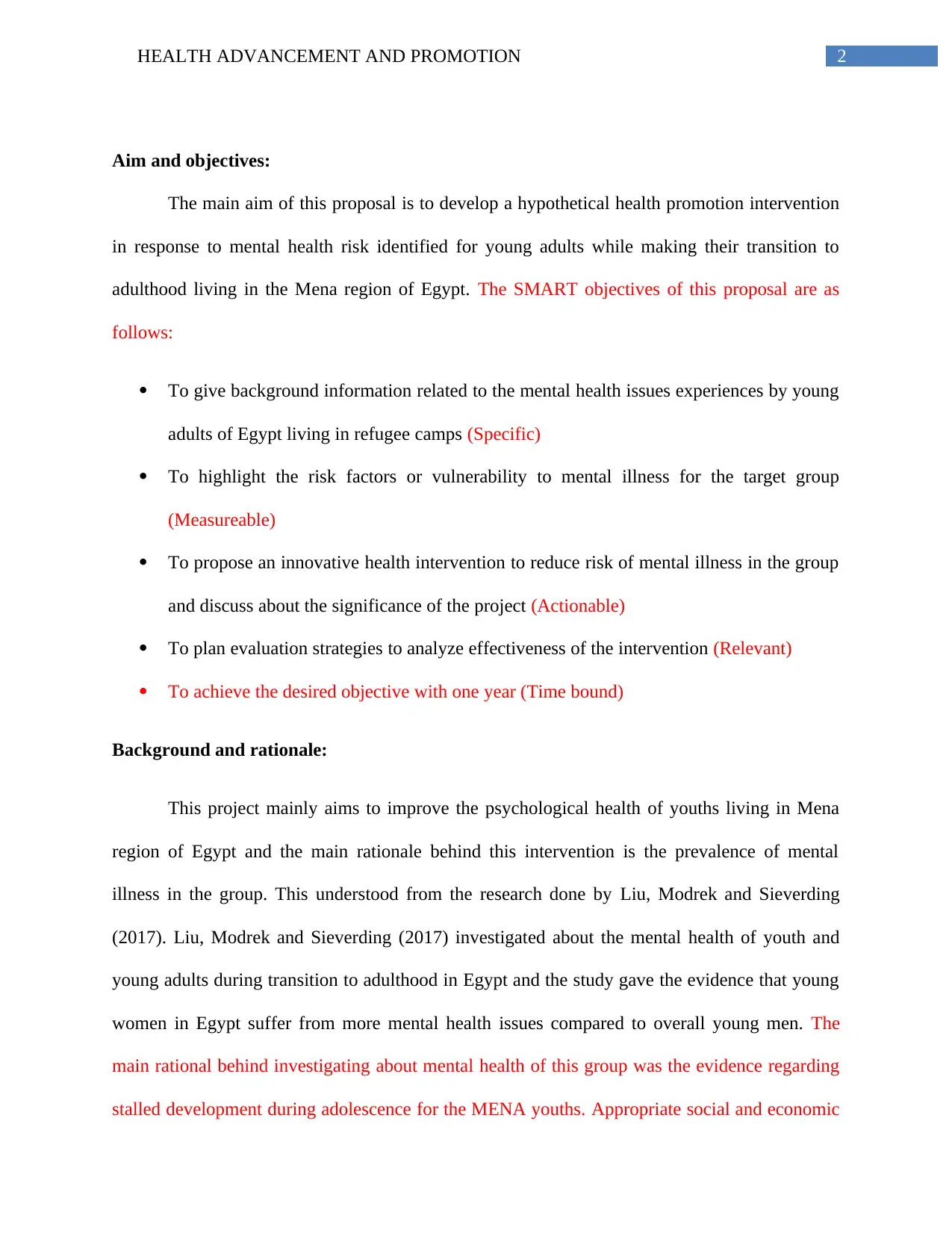
2HEALTH ADVANCEMENT AND PROMOTION
Aim and objectives:
The main aim of this proposal is to develop a hypothetical health promotion intervention
in response to mental health risk identified for young adults while making their transition to
adulthood living in the Mena region of Egypt. The SMART objectives of this proposal are as
follows:
To give background information related to the mental health issues experiences by young
adults of Egypt living in refugee camps (Specific)
To highlight the risk factors or vulnerability to mental illness for the target group
(Measureable)
To propose an innovative health intervention to reduce risk of mental illness in the group
and discuss about the significance of the project (Actionable)
To plan evaluation strategies to analyze effectiveness of the intervention (Relevant)
To achieve the desired objective with one year (Time bound)
Background and rationale:
This project mainly aims to improve the psychological health of youths living in Mena
region of Egypt and the main rationale behind this intervention is the prevalence of mental
illness in the group. This understood from the research done by Liu, Modrek and Sieverding
(2017). Liu, Modrek and Sieverding (2017) investigated about the mental health of youth and
young adults during transition to adulthood in Egypt and the study gave the evidence that young
women in Egypt suffer from more mental health issues compared to overall young men. The
main rational behind investigating about mental health of this group was the evidence regarding
stalled development during adolescence for the MENA youths. Appropriate social and economic
Aim and objectives:
The main aim of this proposal is to develop a hypothetical health promotion intervention
in response to mental health risk identified for young adults while making their transition to
adulthood living in the Mena region of Egypt. The SMART objectives of this proposal are as
follows:
To give background information related to the mental health issues experiences by young
adults of Egypt living in refugee camps (Specific)
To highlight the risk factors or vulnerability to mental illness for the target group
(Measureable)
To propose an innovative health intervention to reduce risk of mental illness in the group
and discuss about the significance of the project (Actionable)
To plan evaluation strategies to analyze effectiveness of the intervention (Relevant)
To achieve the desired objective with one year (Time bound)
Background and rationale:
This project mainly aims to improve the psychological health of youths living in Mena
region of Egypt and the main rationale behind this intervention is the prevalence of mental
illness in the group. This understood from the research done by Liu, Modrek and Sieverding
(2017). Liu, Modrek and Sieverding (2017) investigated about the mental health of youth and
young adults during transition to adulthood in Egypt and the study gave the evidence that young
women in Egypt suffer from more mental health issues compared to overall young men. The
main rational behind investigating about mental health of this group was the evidence regarding
stalled development during adolescence for the MENA youths. Appropriate social and economic
⊘ This is a preview!⊘
Do you want full access?
Subscribe today to unlock all pages.

Trusted by 1+ million students worldwide
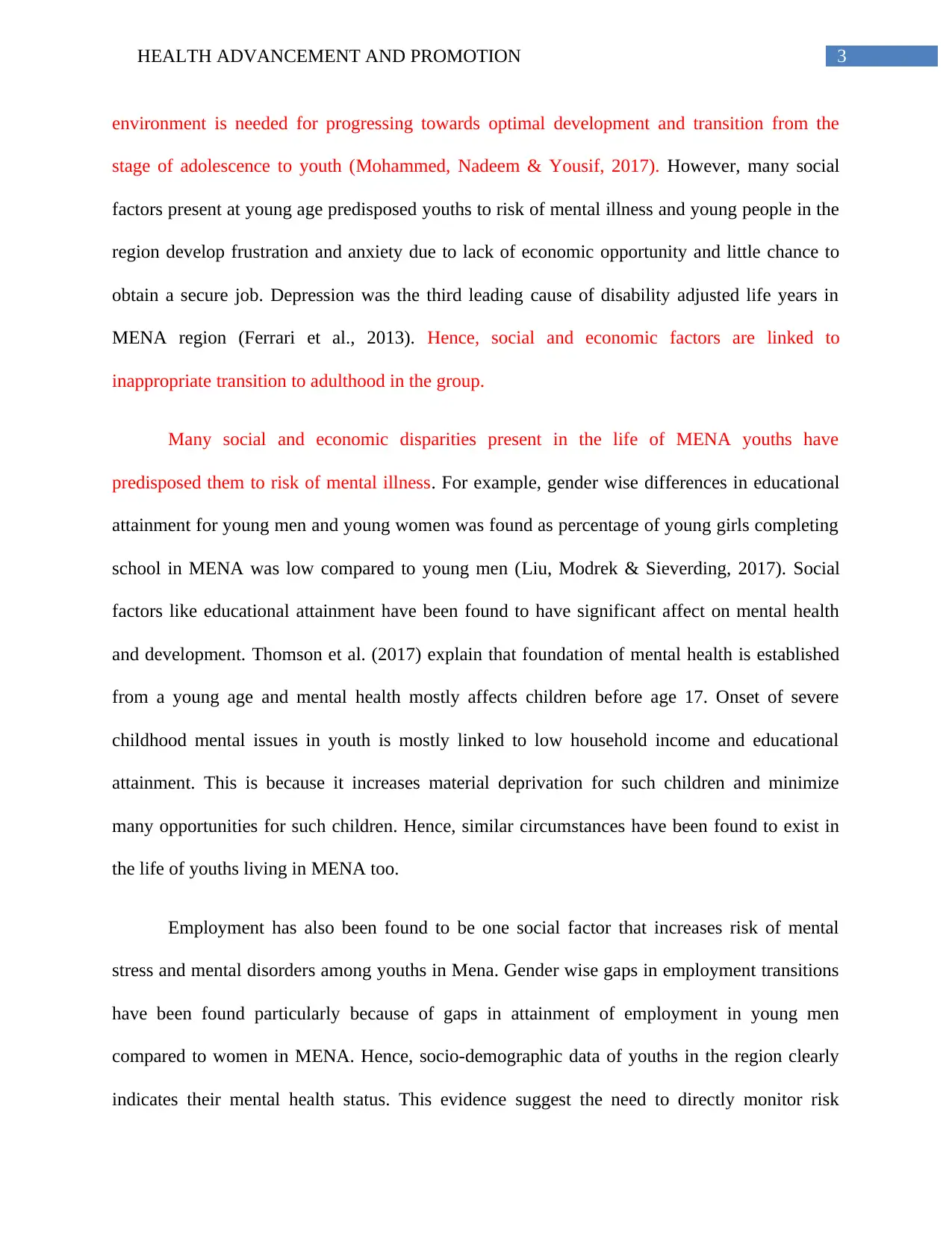
3HEALTH ADVANCEMENT AND PROMOTION
environment is needed for progressing towards optimal development and transition from the
stage of adolescence to youth (Mohammed, Nadeem & Yousif, 2017). However, many social
factors present at young age predisposed youths to risk of mental illness and young people in the
region develop frustration and anxiety due to lack of economic opportunity and little chance to
obtain a secure job. Depression was the third leading cause of disability adjusted life years in
MENA region (Ferrari et al., 2013). Hence, social and economic factors are linked to
inappropriate transition to adulthood in the group.
Many social and economic disparities present in the life of MENA youths have
predisposed them to risk of mental illness. For example, gender wise differences in educational
attainment for young men and young women was found as percentage of young girls completing
school in MENA was low compared to young men (Liu, Modrek & Sieverding, 2017). Social
factors like educational attainment have been found to have significant affect on mental health
and development. Thomson et al. (2017) explain that foundation of mental health is established
from a young age and mental health mostly affects children before age 17. Onset of severe
childhood mental issues in youth is mostly linked to low household income and educational
attainment. This is because it increases material deprivation for such children and minimize
many opportunities for such children. Hence, similar circumstances have been found to exist in
the life of youths living in MENA too.
Employment has also been found to be one social factor that increases risk of mental
stress and mental disorders among youths in Mena. Gender wise gaps in employment transitions
have been found particularly because of gaps in attainment of employment in young men
compared to women in MENA. Hence, socio-demographic data of youths in the region clearly
indicates their mental health status. This evidence suggest the need to directly monitor risk
environment is needed for progressing towards optimal development and transition from the
stage of adolescence to youth (Mohammed, Nadeem & Yousif, 2017). However, many social
factors present at young age predisposed youths to risk of mental illness and young people in the
region develop frustration and anxiety due to lack of economic opportunity and little chance to
obtain a secure job. Depression was the third leading cause of disability adjusted life years in
MENA region (Ferrari et al., 2013). Hence, social and economic factors are linked to
inappropriate transition to adulthood in the group.
Many social and economic disparities present in the life of MENA youths have
predisposed them to risk of mental illness. For example, gender wise differences in educational
attainment for young men and young women was found as percentage of young girls completing
school in MENA was low compared to young men (Liu, Modrek & Sieverding, 2017). Social
factors like educational attainment have been found to have significant affect on mental health
and development. Thomson et al. (2017) explain that foundation of mental health is established
from a young age and mental health mostly affects children before age 17. Onset of severe
childhood mental issues in youth is mostly linked to low household income and educational
attainment. This is because it increases material deprivation for such children and minimize
many opportunities for such children. Hence, similar circumstances have been found to exist in
the life of youths living in MENA too.
Employment has also been found to be one social factor that increases risk of mental
stress and mental disorders among youths in Mena. Gender wise gaps in employment transitions
have been found particularly because of gaps in attainment of employment in young men
compared to women in MENA. Hence, socio-demographic data of youths in the region clearly
indicates their mental health status. This evidence suggest the need to directly monitor risk
Paraphrase This Document
Need a fresh take? Get an instant paraphrase of this document with our AI Paraphraser
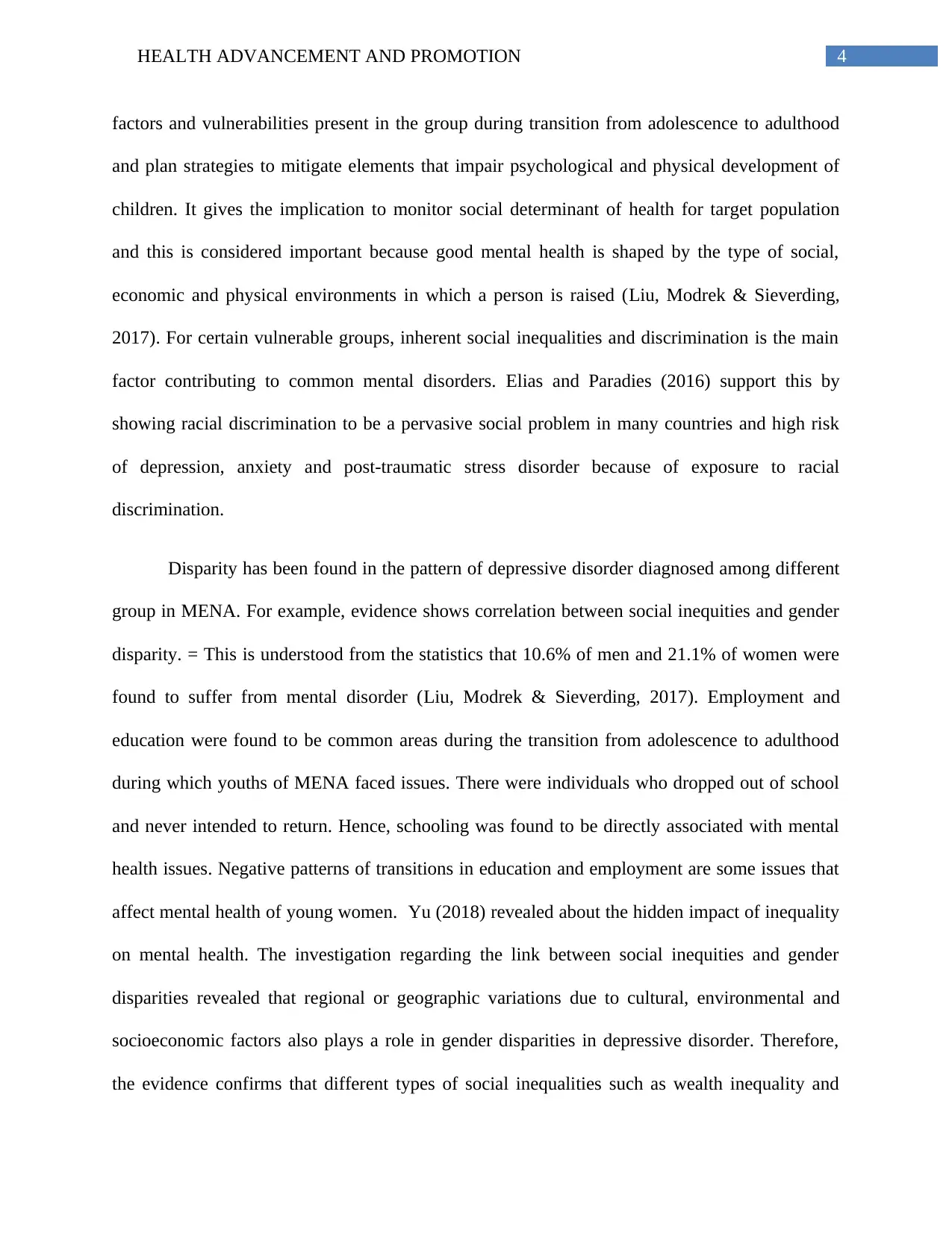
4HEALTH ADVANCEMENT AND PROMOTION
factors and vulnerabilities present in the group during transition from adolescence to adulthood
and plan strategies to mitigate elements that impair psychological and physical development of
children. It gives the implication to monitor social determinant of health for target population
and this is considered important because good mental health is shaped by the type of social,
economic and physical environments in which a person is raised (Liu, Modrek & Sieverding,
2017). For certain vulnerable groups, inherent social inequalities and discrimination is the main
factor contributing to common mental disorders. Elias and Paradies (2016) support this by
showing racial discrimination to be a pervasive social problem in many countries and high risk
of depression, anxiety and post-traumatic stress disorder because of exposure to racial
discrimination.
Disparity has been found in the pattern of depressive disorder diagnosed among different
group in MENA. For example, evidence shows correlation between social inequities and gender
disparity. = This is understood from the statistics that 10.6% of men and 21.1% of women were
found to suffer from mental disorder (Liu, Modrek & Sieverding, 2017). Employment and
education were found to be common areas during the transition from adolescence to adulthood
during which youths of MENA faced issues. There were individuals who dropped out of school
and never intended to return. Hence, schooling was found to be directly associated with mental
health issues. Negative patterns of transitions in education and employment are some issues that
affect mental health of young women. Yu (2018) revealed about the hidden impact of inequality
on mental health. The investigation regarding the link between social inequities and gender
disparities revealed that regional or geographic variations due to cultural, environmental and
socioeconomic factors also plays a role in gender disparities in depressive disorder. Therefore,
the evidence confirms that different types of social inequalities such as wealth inequality and
factors and vulnerabilities present in the group during transition from adolescence to adulthood
and plan strategies to mitigate elements that impair psychological and physical development of
children. It gives the implication to monitor social determinant of health for target population
and this is considered important because good mental health is shaped by the type of social,
economic and physical environments in which a person is raised (Liu, Modrek & Sieverding,
2017). For certain vulnerable groups, inherent social inequalities and discrimination is the main
factor contributing to common mental disorders. Elias and Paradies (2016) support this by
showing racial discrimination to be a pervasive social problem in many countries and high risk
of depression, anxiety and post-traumatic stress disorder because of exposure to racial
discrimination.
Disparity has been found in the pattern of depressive disorder diagnosed among different
group in MENA. For example, evidence shows correlation between social inequities and gender
disparity. = This is understood from the statistics that 10.6% of men and 21.1% of women were
found to suffer from mental disorder (Liu, Modrek & Sieverding, 2017). Employment and
education were found to be common areas during the transition from adolescence to adulthood
during which youths of MENA faced issues. There were individuals who dropped out of school
and never intended to return. Hence, schooling was found to be directly associated with mental
health issues. Negative patterns of transitions in education and employment are some issues that
affect mental health of young women. Yu (2018) revealed about the hidden impact of inequality
on mental health. The investigation regarding the link between social inequities and gender
disparities revealed that regional or geographic variations due to cultural, environmental and
socioeconomic factors also plays a role in gender disparities in depressive disorder. Therefore,
the evidence confirms that different types of social inequalities such as wealth inequality and
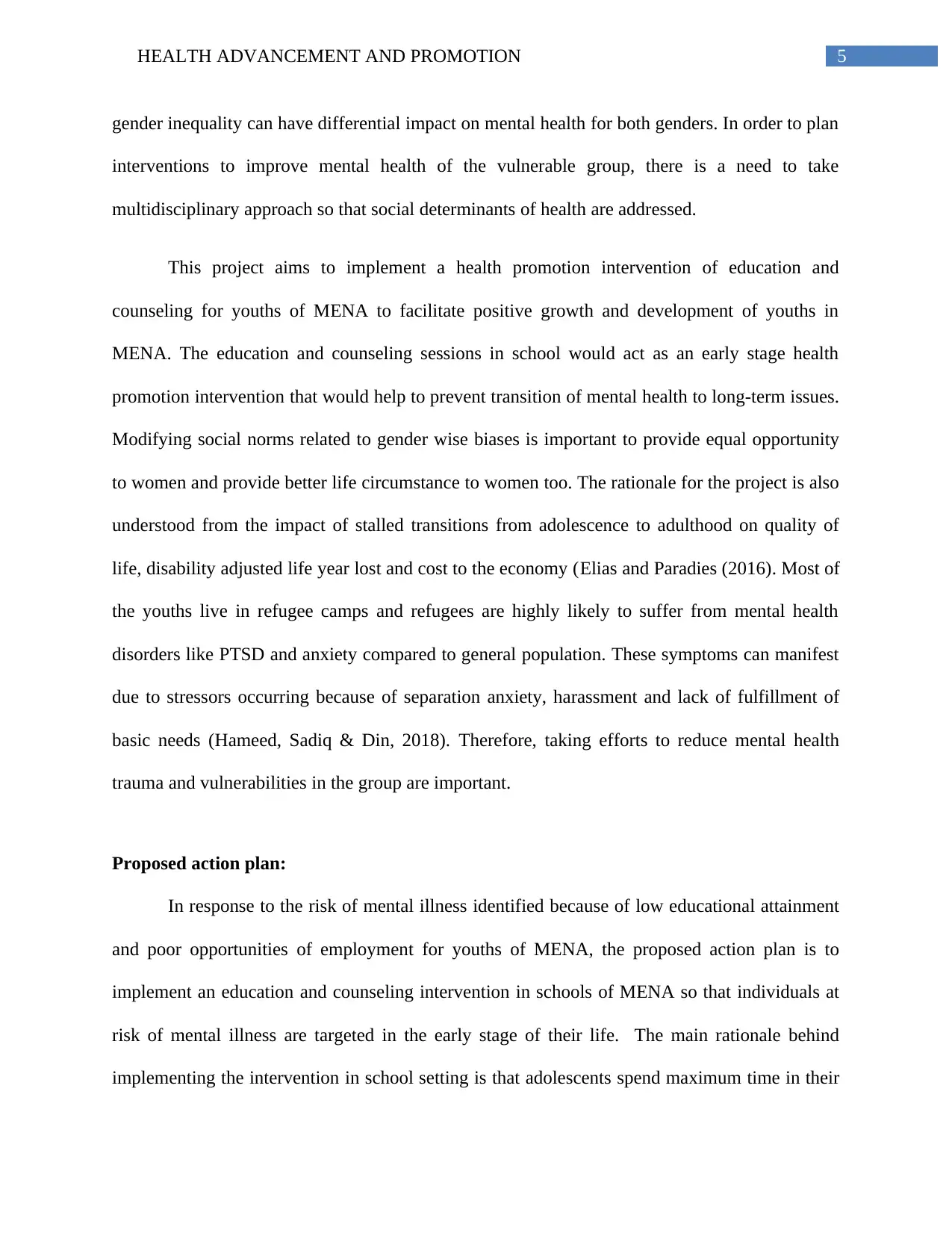
5HEALTH ADVANCEMENT AND PROMOTION
gender inequality can have differential impact on mental health for both genders. In order to plan
interventions to improve mental health of the vulnerable group, there is a need to take
multidisciplinary approach so that social determinants of health are addressed.
This project aims to implement a health promotion intervention of education and
counseling for youths of MENA to facilitate positive growth and development of youths in
MENA. The education and counseling sessions in school would act as an early stage health
promotion intervention that would help to prevent transition of mental health to long-term issues.
Modifying social norms related to gender wise biases is important to provide equal opportunity
to women and provide better life circumstance to women too. The rationale for the project is also
understood from the impact of stalled transitions from adolescence to adulthood on quality of
life, disability adjusted life year lost and cost to the economy (Elias and Paradies (2016). Most of
the youths live in refugee camps and refugees are highly likely to suffer from mental health
disorders like PTSD and anxiety compared to general population. These symptoms can manifest
due to stressors occurring because of separation anxiety, harassment and lack of fulfillment of
basic needs (Hameed, Sadiq & Din, 2018). Therefore, taking efforts to reduce mental health
trauma and vulnerabilities in the group are important.
Proposed action plan:
In response to the risk of mental illness identified because of low educational attainment
and poor opportunities of employment for youths of MENA, the proposed action plan is to
implement an education and counseling intervention in schools of MENA so that individuals at
risk of mental illness are targeted in the early stage of their life. The main rationale behind
implementing the intervention in school setting is that adolescents spend maximum time in their
gender inequality can have differential impact on mental health for both genders. In order to plan
interventions to improve mental health of the vulnerable group, there is a need to take
multidisciplinary approach so that social determinants of health are addressed.
This project aims to implement a health promotion intervention of education and
counseling for youths of MENA to facilitate positive growth and development of youths in
MENA. The education and counseling sessions in school would act as an early stage health
promotion intervention that would help to prevent transition of mental health to long-term issues.
Modifying social norms related to gender wise biases is important to provide equal opportunity
to women and provide better life circumstance to women too. The rationale for the project is also
understood from the impact of stalled transitions from adolescence to adulthood on quality of
life, disability adjusted life year lost and cost to the economy (Elias and Paradies (2016). Most of
the youths live in refugee camps and refugees are highly likely to suffer from mental health
disorders like PTSD and anxiety compared to general population. These symptoms can manifest
due to stressors occurring because of separation anxiety, harassment and lack of fulfillment of
basic needs (Hameed, Sadiq & Din, 2018). Therefore, taking efforts to reduce mental health
trauma and vulnerabilities in the group are important.
Proposed action plan:
In response to the risk of mental illness identified because of low educational attainment
and poor opportunities of employment for youths of MENA, the proposed action plan is to
implement an education and counseling intervention in schools of MENA so that individuals at
risk of mental illness are targeted in the early stage of their life. The main rationale behind
implementing the intervention in school setting is that adolescents spend maximum time in their
⊘ This is a preview!⊘
Do you want full access?
Subscribe today to unlock all pages.

Trusted by 1+ million students worldwide
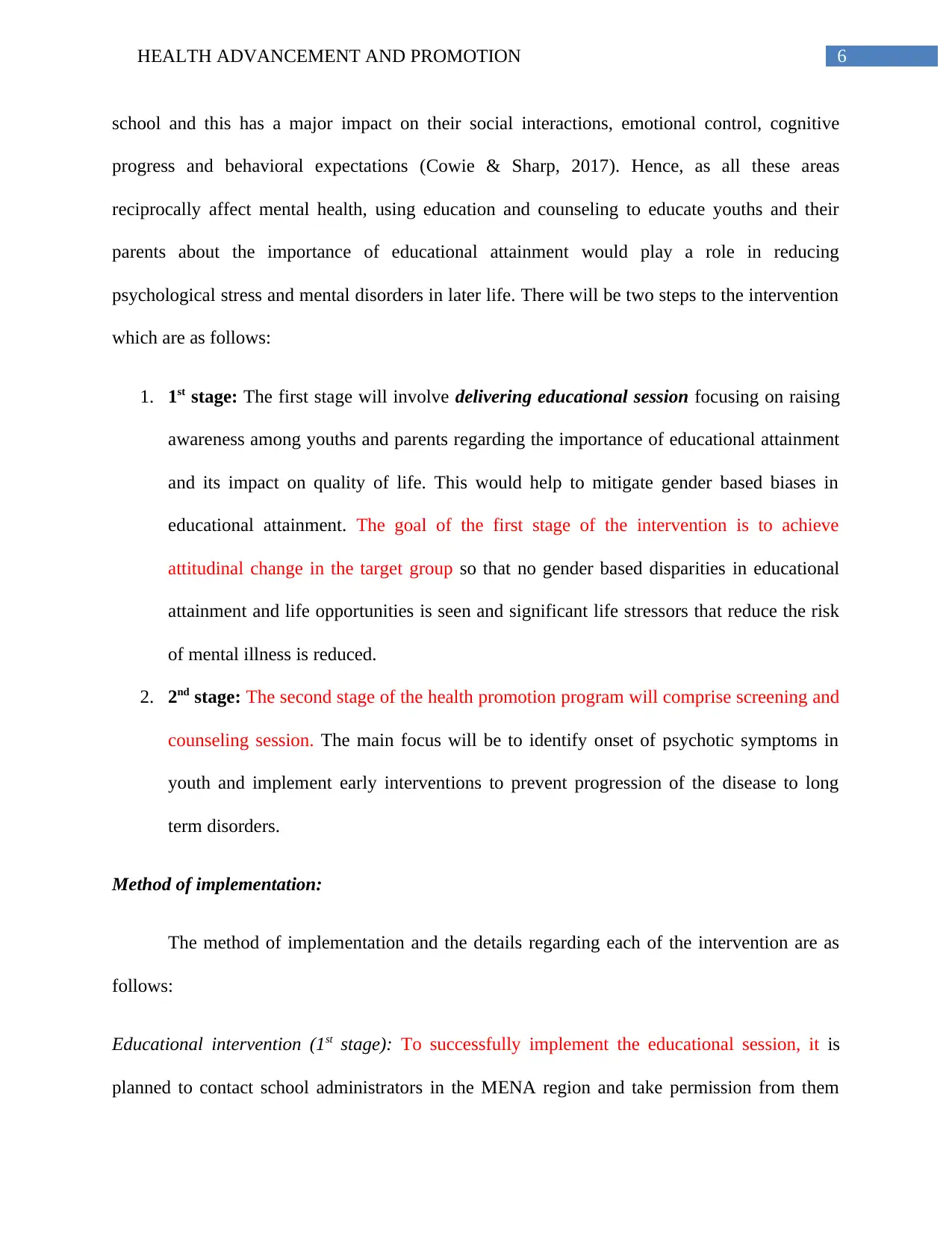
6HEALTH ADVANCEMENT AND PROMOTION
school and this has a major impact on their social interactions, emotional control, cognitive
progress and behavioral expectations (Cowie & Sharp, 2017). Hence, as all these areas
reciprocally affect mental health, using education and counseling to educate youths and their
parents about the importance of educational attainment would play a role in reducing
psychological stress and mental disorders in later life. There will be two steps to the intervention
which are as follows:
1. 1st stage: The first stage will involve delivering educational session focusing on raising
awareness among youths and parents regarding the importance of educational attainment
and its impact on quality of life. This would help to mitigate gender based biases in
educational attainment. The goal of the first stage of the intervention is to achieve
attitudinal change in the target group so that no gender based disparities in educational
attainment and life opportunities is seen and significant life stressors that reduce the risk
of mental illness is reduced.
2. 2nd stage: The second stage of the health promotion program will comprise screening and
counseling session. The main focus will be to identify onset of psychotic symptoms in
youth and implement early interventions to prevent progression of the disease to long
term disorders.
Method of implementation:
The method of implementation and the details regarding each of the intervention are as
follows:
Educational intervention (1st stage): To successfully implement the educational session, it is
planned to contact school administrators in the MENA region and take permission from them
school and this has a major impact on their social interactions, emotional control, cognitive
progress and behavioral expectations (Cowie & Sharp, 2017). Hence, as all these areas
reciprocally affect mental health, using education and counseling to educate youths and their
parents about the importance of educational attainment would play a role in reducing
psychological stress and mental disorders in later life. There will be two steps to the intervention
which are as follows:
1. 1st stage: The first stage will involve delivering educational session focusing on raising
awareness among youths and parents regarding the importance of educational attainment
and its impact on quality of life. This would help to mitigate gender based biases in
educational attainment. The goal of the first stage of the intervention is to achieve
attitudinal change in the target group so that no gender based disparities in educational
attainment and life opportunities is seen and significant life stressors that reduce the risk
of mental illness is reduced.
2. 2nd stage: The second stage of the health promotion program will comprise screening and
counseling session. The main focus will be to identify onset of psychotic symptoms in
youth and implement early interventions to prevent progression of the disease to long
term disorders.
Method of implementation:
The method of implementation and the details regarding each of the intervention are as
follows:
Educational intervention (1st stage): To successfully implement the educational session, it is
planned to contact school administrators in the MENA region and take permission from them
Paraphrase This Document
Need a fresh take? Get an instant paraphrase of this document with our AI Paraphraser
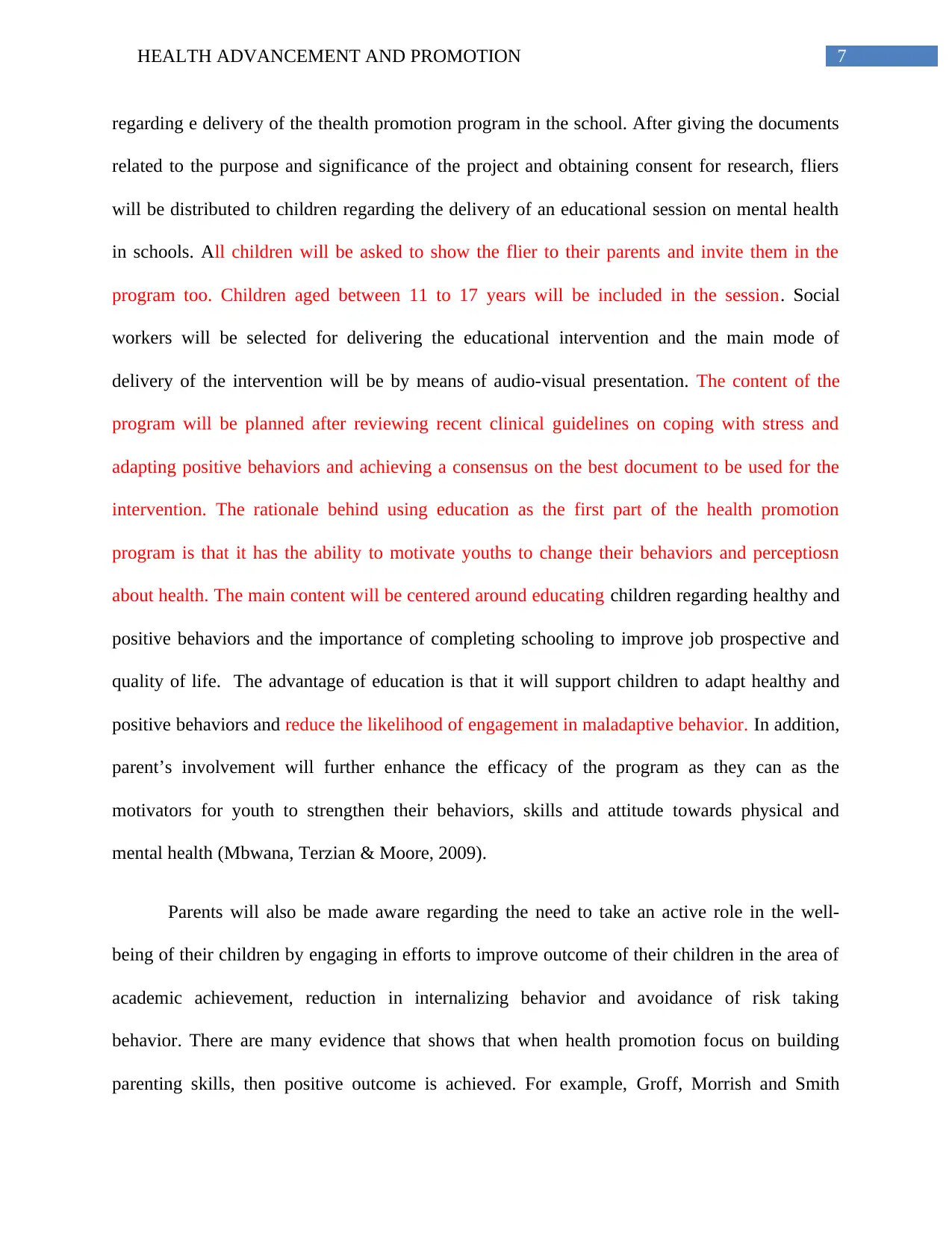
7HEALTH ADVANCEMENT AND PROMOTION
regarding e delivery of the thealth promotion program in the school. After giving the documents
related to the purpose and significance of the project and obtaining consent for research, fliers
will be distributed to children regarding the delivery of an educational session on mental health
in schools. All children will be asked to show the flier to their parents and invite them in the
program too. Children aged between 11 to 17 years will be included in the session. Social
workers will be selected for delivering the educational intervention and the main mode of
delivery of the intervention will be by means of audio-visual presentation. The content of the
program will be planned after reviewing recent clinical guidelines on coping with stress and
adapting positive behaviors and achieving a consensus on the best document to be used for the
intervention. The rationale behind using education as the first part of the health promotion
program is that it has the ability to motivate youths to change their behaviors and perceptiosn
about health. The main content will be centered around educating children regarding healthy and
positive behaviors and the importance of completing schooling to improve job prospective and
quality of life. The advantage of education is that it will support children to adapt healthy and
positive behaviors and reduce the likelihood of engagement in maladaptive behavior. In addition,
parent’s involvement will further enhance the efficacy of the program as they can as the
motivators for youth to strengthen their behaviors, skills and attitude towards physical and
mental health (Mbwana, Terzian & Moore, 2009).
Parents will also be made aware regarding the need to take an active role in the well-
being of their children by engaging in efforts to improve outcome of their children in the area of
academic achievement, reduction in internalizing behavior and avoidance of risk taking
behavior. There are many evidence that shows that when health promotion focus on building
parenting skills, then positive outcome is achieved. For example, Groff, Morrish and Smith
regarding e delivery of the thealth promotion program in the school. After giving the documents
related to the purpose and significance of the project and obtaining consent for research, fliers
will be distributed to children regarding the delivery of an educational session on mental health
in schools. All children will be asked to show the flier to their parents and invite them in the
program too. Children aged between 11 to 17 years will be included in the session. Social
workers will be selected for delivering the educational intervention and the main mode of
delivery of the intervention will be by means of audio-visual presentation. The content of the
program will be planned after reviewing recent clinical guidelines on coping with stress and
adapting positive behaviors and achieving a consensus on the best document to be used for the
intervention. The rationale behind using education as the first part of the health promotion
program is that it has the ability to motivate youths to change their behaviors and perceptiosn
about health. The main content will be centered around educating children regarding healthy and
positive behaviors and the importance of completing schooling to improve job prospective and
quality of life. The advantage of education is that it will support children to adapt healthy and
positive behaviors and reduce the likelihood of engagement in maladaptive behavior. In addition,
parent’s involvement will further enhance the efficacy of the program as they can as the
motivators for youth to strengthen their behaviors, skills and attitude towards physical and
mental health (Mbwana, Terzian & Moore, 2009).
Parents will also be made aware regarding the need to take an active role in the well-
being of their children by engaging in efforts to improve outcome of their children in the area of
academic achievement, reduction in internalizing behavior and avoidance of risk taking
behavior. There are many evidence that shows that when health promotion focus on building
parenting skills, then positive outcome is achieved. For example, Groff, Morrish and Smith
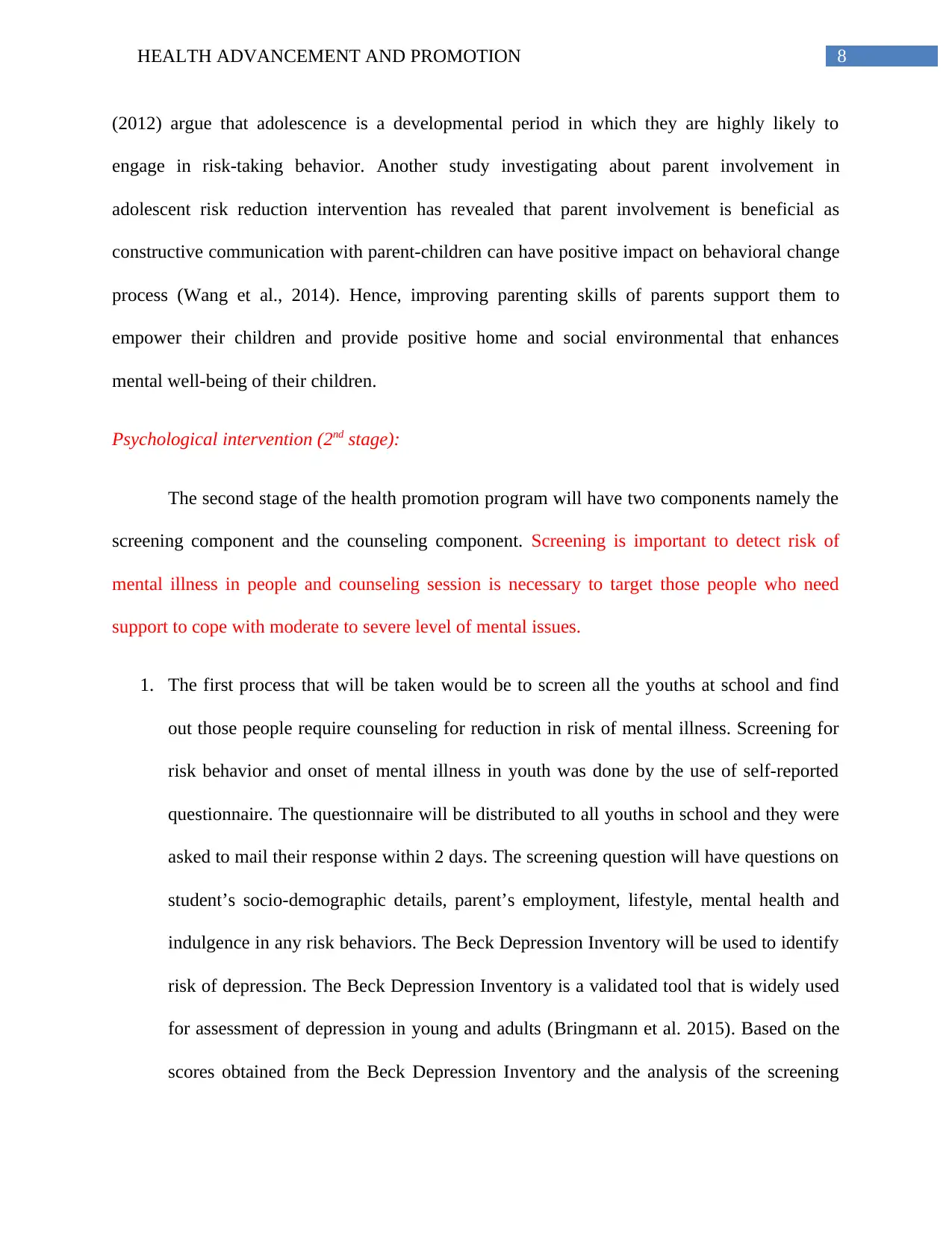
8HEALTH ADVANCEMENT AND PROMOTION
(2012) argue that adolescence is a developmental period in which they are highly likely to
engage in risk-taking behavior. Another study investigating about parent involvement in
adolescent risk reduction intervention has revealed that parent involvement is beneficial as
constructive communication with parent-children can have positive impact on behavioral change
process (Wang et al., 2014). Hence, improving parenting skills of parents support them to
empower their children and provide positive home and social environmental that enhances
mental well-being of their children.
Psychological intervention (2nd stage):
The second stage of the health promotion program will have two components namely the
screening component and the counseling component. Screening is important to detect risk of
mental illness in people and counseling session is necessary to target those people who need
support to cope with moderate to severe level of mental issues.
1. The first process that will be taken would be to screen all the youths at school and find
out those people require counseling for reduction in risk of mental illness. Screening for
risk behavior and onset of mental illness in youth was done by the use of self-reported
questionnaire. The questionnaire will be distributed to all youths in school and they were
asked to mail their response within 2 days. The screening question will have questions on
student’s socio-demographic details, parent’s employment, lifestyle, mental health and
indulgence in any risk behaviors. The Beck Depression Inventory will be used to identify
risk of depression. The Beck Depression Inventory is a validated tool that is widely used
for assessment of depression in young and adults (Bringmann et al. 2015). Based on the
scores obtained from the Beck Depression Inventory and the analysis of the screening
(2012) argue that adolescence is a developmental period in which they are highly likely to
engage in risk-taking behavior. Another study investigating about parent involvement in
adolescent risk reduction intervention has revealed that parent involvement is beneficial as
constructive communication with parent-children can have positive impact on behavioral change
process (Wang et al., 2014). Hence, improving parenting skills of parents support them to
empower their children and provide positive home and social environmental that enhances
mental well-being of their children.
Psychological intervention (2nd stage):
The second stage of the health promotion program will have two components namely the
screening component and the counseling component. Screening is important to detect risk of
mental illness in people and counseling session is necessary to target those people who need
support to cope with moderate to severe level of mental issues.
1. The first process that will be taken would be to screen all the youths at school and find
out those people require counseling for reduction in risk of mental illness. Screening for
risk behavior and onset of mental illness in youth was done by the use of self-reported
questionnaire. The questionnaire will be distributed to all youths in school and they were
asked to mail their response within 2 days. The screening question will have questions on
student’s socio-demographic details, parent’s employment, lifestyle, mental health and
indulgence in any risk behaviors. The Beck Depression Inventory will be used to identify
risk of depression. The Beck Depression Inventory is a validated tool that is widely used
for assessment of depression in young and adults (Bringmann et al. 2015). Based on the
scores obtained from the Beck Depression Inventory and the analysis of the screening
⊘ This is a preview!⊘
Do you want full access?
Subscribe today to unlock all pages.

Trusted by 1+ million students worldwide
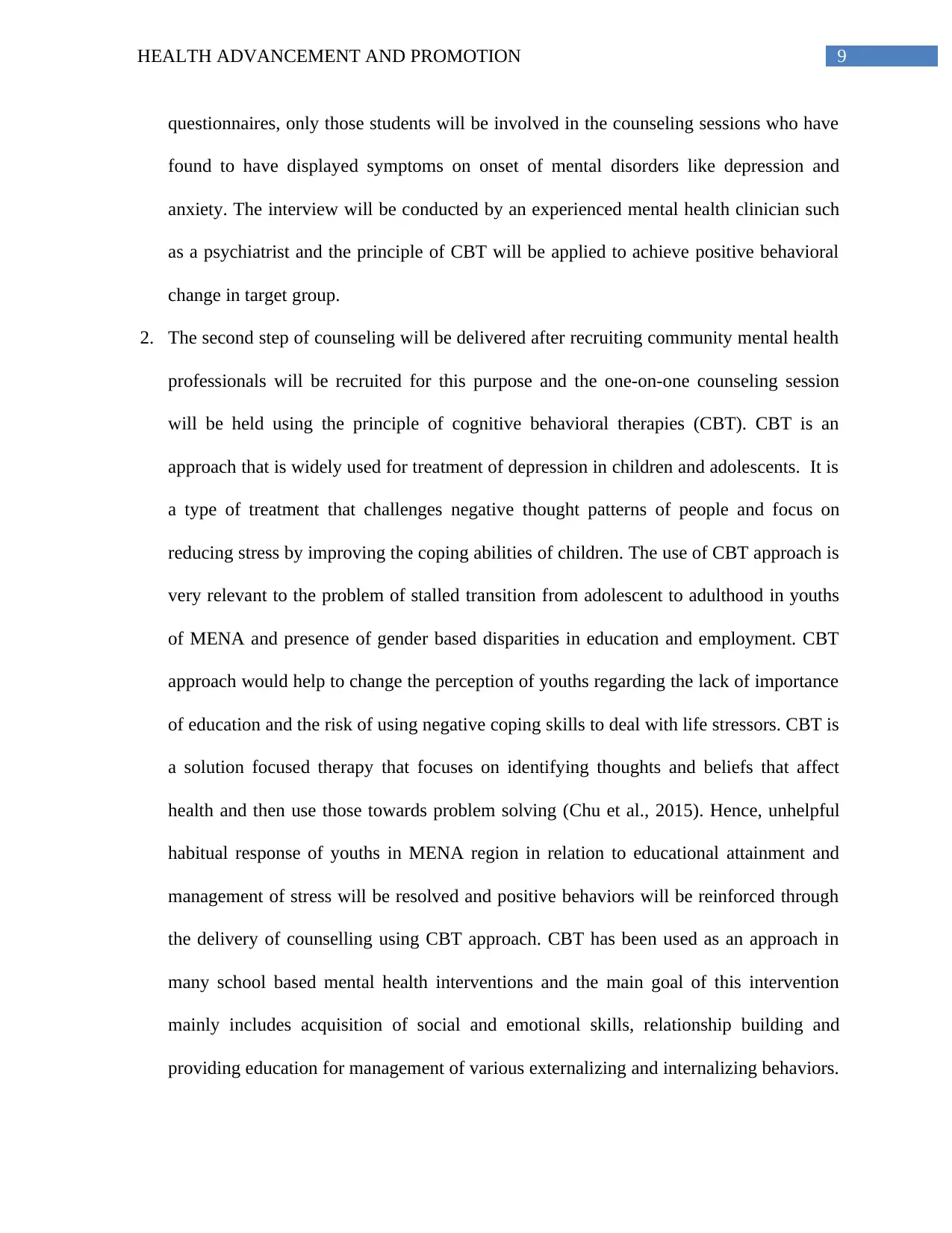
9HEALTH ADVANCEMENT AND PROMOTION
questionnaires, only those students will be involved in the counseling sessions who have
found to have displayed symptoms on onset of mental disorders like depression and
anxiety. The interview will be conducted by an experienced mental health clinician such
as a psychiatrist and the principle of CBT will be applied to achieve positive behavioral
change in target group.
2. The second step of counseling will be delivered after recruiting community mental health
professionals will be recruited for this purpose and the one-on-one counseling session
will be held using the principle of cognitive behavioral therapies (CBT). CBT is an
approach that is widely used for treatment of depression in children and adolescents. It is
a type of treatment that challenges negative thought patterns of people and focus on
reducing stress by improving the coping abilities of children. The use of CBT approach is
very relevant to the problem of stalled transition from adolescent to adulthood in youths
of MENA and presence of gender based disparities in education and employment. CBT
approach would help to change the perception of youths regarding the lack of importance
of education and the risk of using negative coping skills to deal with life stressors. CBT is
a solution focused therapy that focuses on identifying thoughts and beliefs that affect
health and then use those towards problem solving (Chu et al., 2015). Hence, unhelpful
habitual response of youths in MENA region in relation to educational attainment and
management of stress will be resolved and positive behaviors will be reinforced through
the delivery of counselling using CBT approach. CBT has been used as an approach in
many school based mental health interventions and the main goal of this intervention
mainly includes acquisition of social and emotional skills, relationship building and
providing education for management of various externalizing and internalizing behaviors.
questionnaires, only those students will be involved in the counseling sessions who have
found to have displayed symptoms on onset of mental disorders like depression and
anxiety. The interview will be conducted by an experienced mental health clinician such
as a psychiatrist and the principle of CBT will be applied to achieve positive behavioral
change in target group.
2. The second step of counseling will be delivered after recruiting community mental health
professionals will be recruited for this purpose and the one-on-one counseling session
will be held using the principle of cognitive behavioral therapies (CBT). CBT is an
approach that is widely used for treatment of depression in children and adolescents. It is
a type of treatment that challenges negative thought patterns of people and focus on
reducing stress by improving the coping abilities of children. The use of CBT approach is
very relevant to the problem of stalled transition from adolescent to adulthood in youths
of MENA and presence of gender based disparities in education and employment. CBT
approach would help to change the perception of youths regarding the lack of importance
of education and the risk of using negative coping skills to deal with life stressors. CBT is
a solution focused therapy that focuses on identifying thoughts and beliefs that affect
health and then use those towards problem solving (Chu et al., 2015). Hence, unhelpful
habitual response of youths in MENA region in relation to educational attainment and
management of stress will be resolved and positive behaviors will be reinforced through
the delivery of counselling using CBT approach. CBT has been used as an approach in
many school based mental health interventions and the main goal of this intervention
mainly includes acquisition of social and emotional skills, relationship building and
providing education for management of various externalizing and internalizing behaviors.
Paraphrase This Document
Need a fresh take? Get an instant paraphrase of this document with our AI Paraphraser
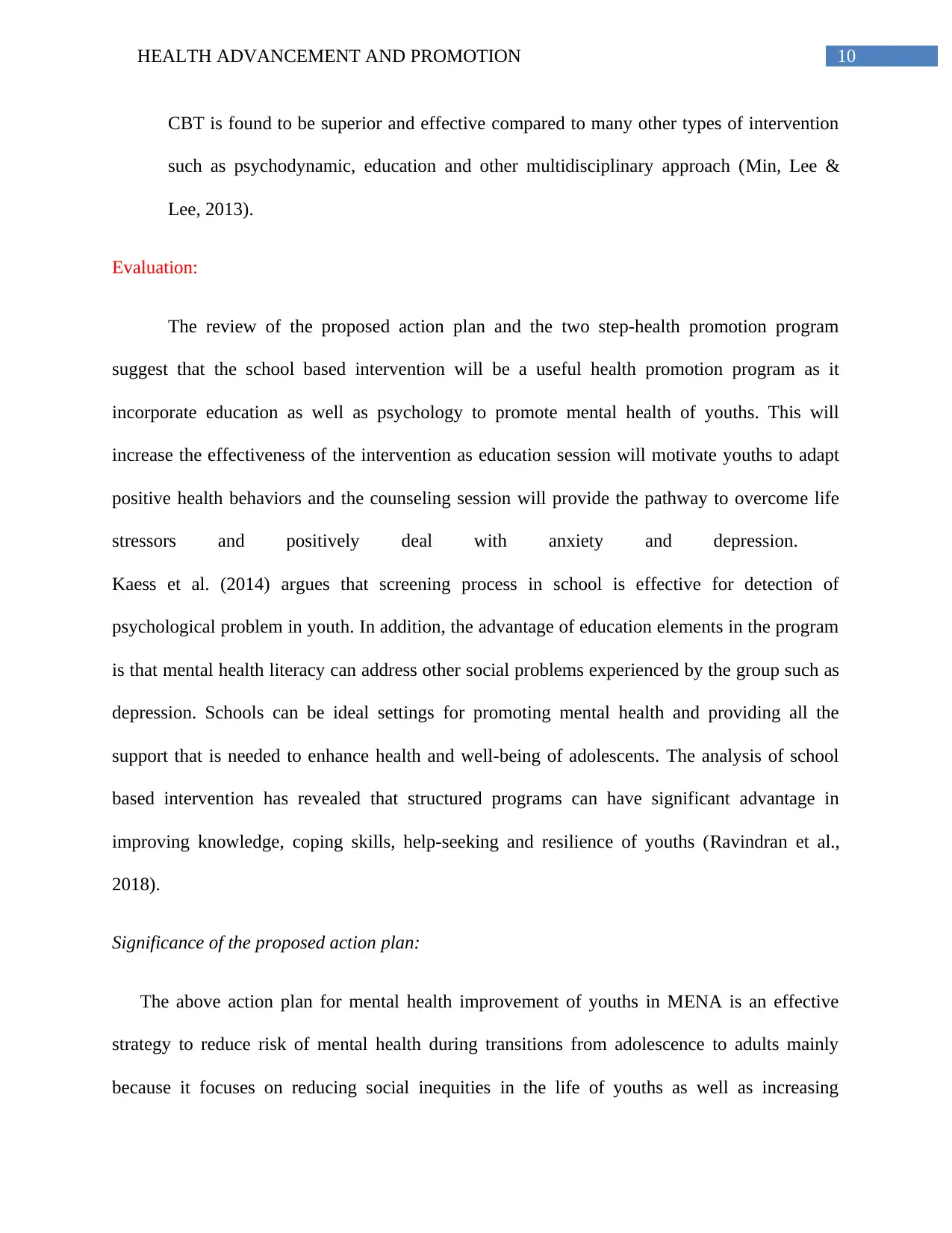
10HEALTH ADVANCEMENT AND PROMOTION
CBT is found to be superior and effective compared to many other types of intervention
such as psychodynamic, education and other multidisciplinary approach (Min, Lee &
Lee, 2013).
Evaluation:
The review of the proposed action plan and the two step-health promotion program
suggest that the school based intervention will be a useful health promotion program as it
incorporate education as well as psychology to promote mental health of youths. This will
increase the effectiveness of the intervention as education session will motivate youths to adapt
positive health behaviors and the counseling session will provide the pathway to overcome life
stressors and positively deal with anxiety and depression.
Kaess et al. (2014) argues that screening process in school is effective for detection of
psychological problem in youth. In addition, the advantage of education elements in the program
is that mental health literacy can address other social problems experienced by the group such as
depression. Schools can be ideal settings for promoting mental health and providing all the
support that is needed to enhance health and well-being of adolescents. The analysis of school
based intervention has revealed that structured programs can have significant advantage in
improving knowledge, coping skills, help-seeking and resilience of youths (Ravindran et al.,
2018).
Significance of the proposed action plan:
The above action plan for mental health improvement of youths in MENA is an effective
strategy to reduce risk of mental health during transitions from adolescence to adults mainly
because it focuses on reducing social inequities in the life of youths as well as increasing
CBT is found to be superior and effective compared to many other types of intervention
such as psychodynamic, education and other multidisciplinary approach (Min, Lee &
Lee, 2013).
Evaluation:
The review of the proposed action plan and the two step-health promotion program
suggest that the school based intervention will be a useful health promotion program as it
incorporate education as well as psychology to promote mental health of youths. This will
increase the effectiveness of the intervention as education session will motivate youths to adapt
positive health behaviors and the counseling session will provide the pathway to overcome life
stressors and positively deal with anxiety and depression.
Kaess et al. (2014) argues that screening process in school is effective for detection of
psychological problem in youth. In addition, the advantage of education elements in the program
is that mental health literacy can address other social problems experienced by the group such as
depression. Schools can be ideal settings for promoting mental health and providing all the
support that is needed to enhance health and well-being of adolescents. The analysis of school
based intervention has revealed that structured programs can have significant advantage in
improving knowledge, coping skills, help-seeking and resilience of youths (Ravindran et al.,
2018).
Significance of the proposed action plan:
The above action plan for mental health improvement of youths in MENA is an effective
strategy to reduce risk of mental health during transitions from adolescence to adults mainly
because it focuses on reducing social inequities in the life of youths as well as increasing
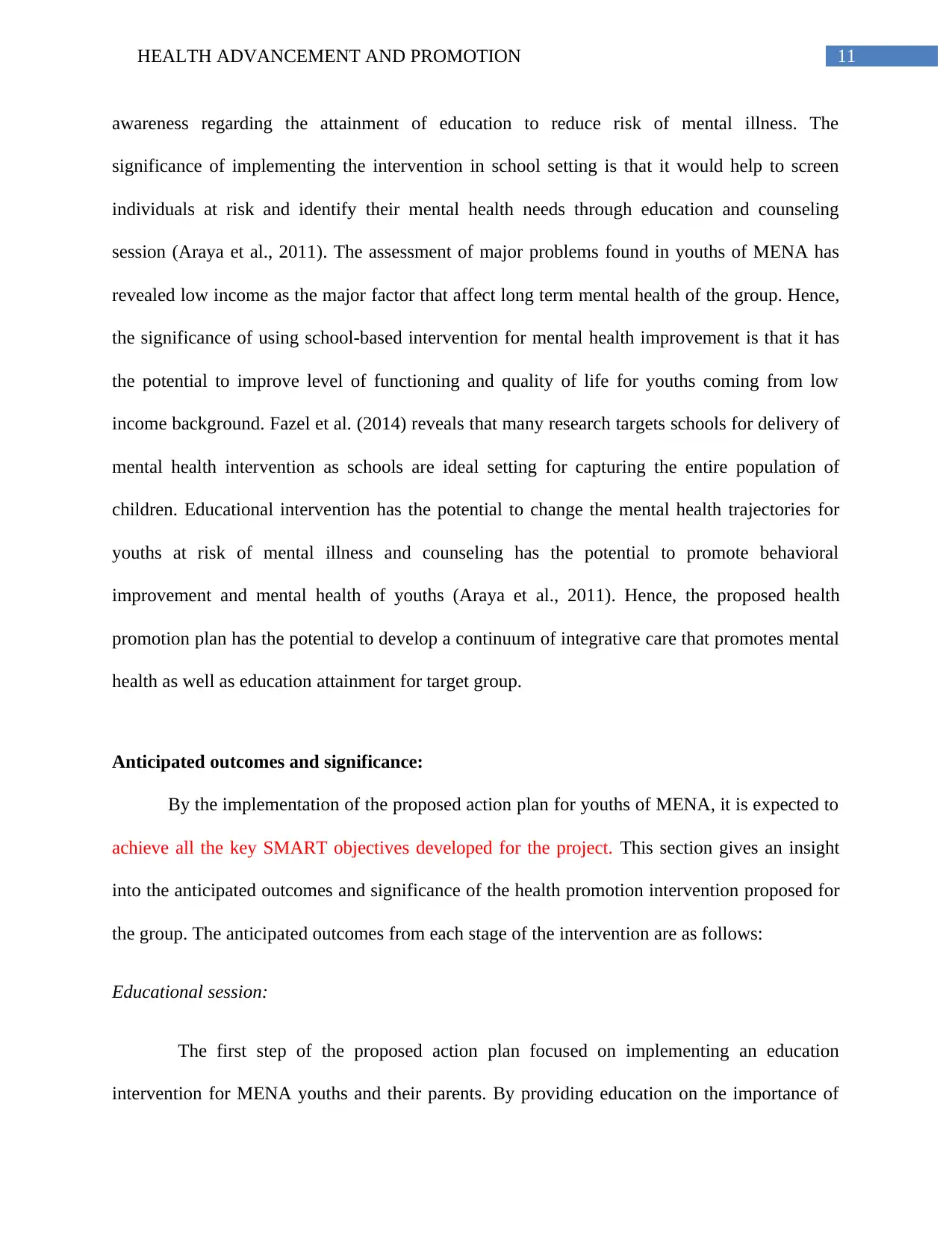
11HEALTH ADVANCEMENT AND PROMOTION
awareness regarding the attainment of education to reduce risk of mental illness. The
significance of implementing the intervention in school setting is that it would help to screen
individuals at risk and identify their mental health needs through education and counseling
session (Araya et al., 2011). The assessment of major problems found in youths of MENA has
revealed low income as the major factor that affect long term mental health of the group. Hence,
the significance of using school-based intervention for mental health improvement is that it has
the potential to improve level of functioning and quality of life for youths coming from low
income background. Fazel et al. (2014) reveals that many research targets schools for delivery of
mental health intervention as schools are ideal setting for capturing the entire population of
children. Educational intervention has the potential to change the mental health trajectories for
youths at risk of mental illness and counseling has the potential to promote behavioral
improvement and mental health of youths (Araya et al., 2011). Hence, the proposed health
promotion plan has the potential to develop a continuum of integrative care that promotes mental
health as well as education attainment for target group.
Anticipated outcomes and significance:
By the implementation of the proposed action plan for youths of MENA, it is expected to
achieve all the key SMART objectives developed for the project. This section gives an insight
into the anticipated outcomes and significance of the health promotion intervention proposed for
the group. The anticipated outcomes from each stage of the intervention are as follows:
Educational session:
The first step of the proposed action plan focused on implementing an education
intervention for MENA youths and their parents. By providing education on the importance of
awareness regarding the attainment of education to reduce risk of mental illness. The
significance of implementing the intervention in school setting is that it would help to screen
individuals at risk and identify their mental health needs through education and counseling
session (Araya et al., 2011). The assessment of major problems found in youths of MENA has
revealed low income as the major factor that affect long term mental health of the group. Hence,
the significance of using school-based intervention for mental health improvement is that it has
the potential to improve level of functioning and quality of life for youths coming from low
income background. Fazel et al. (2014) reveals that many research targets schools for delivery of
mental health intervention as schools are ideal setting for capturing the entire population of
children. Educational intervention has the potential to change the mental health trajectories for
youths at risk of mental illness and counseling has the potential to promote behavioral
improvement and mental health of youths (Araya et al., 2011). Hence, the proposed health
promotion plan has the potential to develop a continuum of integrative care that promotes mental
health as well as education attainment for target group.
Anticipated outcomes and significance:
By the implementation of the proposed action plan for youths of MENA, it is expected to
achieve all the key SMART objectives developed for the project. This section gives an insight
into the anticipated outcomes and significance of the health promotion intervention proposed for
the group. The anticipated outcomes from each stage of the intervention are as follows:
Educational session:
The first step of the proposed action plan focused on implementing an education
intervention for MENA youths and their parents. By providing education on the importance of
⊘ This is a preview!⊘
Do you want full access?
Subscribe today to unlock all pages.

Trusted by 1+ million students worldwide
1 out of 23
Related Documents
Your All-in-One AI-Powered Toolkit for Academic Success.
+13062052269
info@desklib.com
Available 24*7 on WhatsApp / Email
![[object Object]](/_next/static/media/star-bottom.7253800d.svg)
Unlock your academic potential
Copyright © 2020–2025 A2Z Services. All Rights Reserved. Developed and managed by ZUCOL.





